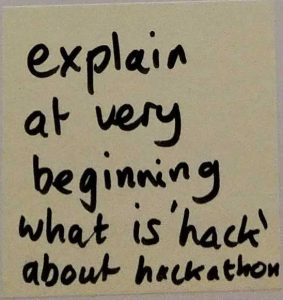[M3L0] How to Develop a Prototype with Design Thinking
This module is an introduction to the way we will work together in the Hands:On Hackathon to create our digital products — using prototyping and design thinking. The approach we take is a method of designing digital things that is commonly used in professional contexts, such as commercial digital agencies and software development teams.
By following this module you will arrive at the Hackathon already familiar with many concepts that we will introduce on the first and subsequent days, so you will have more headspace to focus on teamwork and creativity. You will also be equipped with a working understanding of professional practices you may wish to apply in your career, either within a digital humanities project or outside academia.
By the end of this module you will be able to:
- Define what is ‘prototyping’ and ‘design thinking’;
- Recognise the benefits to creativity of rapid prototyping;
- Learn about the design thinking cycle for creating and improving prototypes;
- Create web app prototypes using paper.
“What is hack about hackathon?”
Here at Hands:On we love feedback. Throughout your time at the Hackathon you will give and receive feedback on your designs many times — informally throughout each day, at the end-of-day roundups, at the user research labs, and at the final presentation. Every time you give or receive feedback is a chance to review, improve and ultimately create a better experience for the people who will use what you make.
Even as organisers we are keen to receive feedback and improve. The Post-It note below is some feedback Chris and I received following a 30-minute micro-hackathon we lead in January 2019. It says “explain at very beginning what is ‘hack’ about hackathon”. We had forgotten to define at the start what a ‘hackathon’ actually is!

All too often it is easy to make assumptions about what your audience knows. As a result what you create — or in this case, what we presented — is not as clear as it could have been. Perhaps this person felt confused throughout the micro-hackathon experience and didn’t get as much out of it as they could have done. If instead we had been designing a government website or a road sign the consequences of that confusion might have been profound.
Throughout the Hands:On Hackathon we will encourage you to step outside your own identity as an academic with your particular specialism and examine your implicit knowledge. Key to this will be giving and receiving feedback at every stage of the process, so that you can gather insights into other people’s perspectives and meet the needs of your target users, who will not necessarily be anything like you.
So, in the spirit of improving after feedback, what is ‘hack’ about hackathon? The word ‘hackathon’ has its origins in the software world. It is a portmanteau of ‘hack’ and ‘marathon’, where ‘hack’ is used in the original sense of ‘exploratory programming’ rather than in its common association with nefarious programmers. So the earliest hackathons were events where a group of software developers assembled and built new technology over a short, intense period. Since then the concept has evolved and hackathons are now widely held in business, academic and charitable contexts to bring people together and kickstart new ideas of all kinds.
Here are some reasons why you might hold or participate in a hackathon:
- Experiment with fresh ideas
- Step outside your comfort zone
- Explore a particular topic in detail
- Fail in a safe space
- Invite collaboration
- Encourage inclusive environments
- Open up to change
- Learn something new
My own definition of hackathon is:
Making something quickly in the spirit of exploration.
Further reading (optional):
‘Hackathon’ on Wikipedia: https://en.wikipedia.org/wiki/Hackathon
So, what is it that you will be making? Go to the Next Lesson >